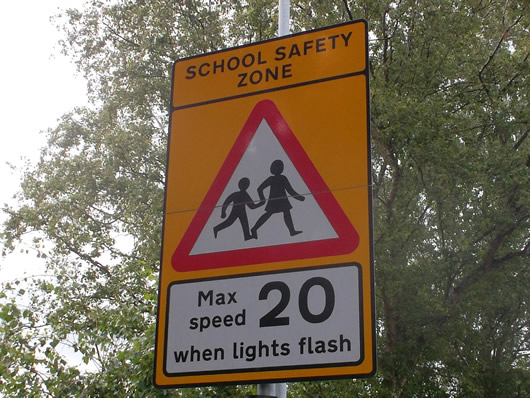20mph Speed Limits - Progress or Inconvenience?
Never has a road safety issue caused so much division.

A recent survey conducted by the Institute of Advanced Motorists showed that the majority of drivers did not support urban 20 MPH limits. See: Drivers' opinions of 20mph speed limits. However I cannot help wondering how different the results would be if it was a different set of road users who were surveyed such as 'Pedestrians' or 'Cyclists' or how different the answers would be if the survey was conducted on a group such as 'The Elderly', 'Parents' or 'Shoppers'.
As a group, 'Drivers' obviously want to get to their destination as quickly and as conveniently as possible. At the outset, 20 mph limits do not appear to achieve that as 20 mph limits will cause: a reduction in the maximum speed allowed, a higher risk of prosecution (for breaking the limit) and possibly longer journey times. Therefore, it is no surprise really that the majority of drivers do not support 20 mph limits.
However, I think we need to look at the whole issue on balance and the overall benefits or disadvantages to everyone, rather than trying to argue from a certain point of view. Those who are for 20 mph limits tend to argue on grounds of safety, while those against 20 mph limits argue that they would make no difference to safety but just inconvenience the motorist.
The Arguments Against 20 mph Limits
20 mph limits will mean my car journey time will take longer.
On straight runs where there are no traffic lights or junctions, the reduction from 20 mph to 30 mph would add 1 minute per mile when driving at the maximum permissible speed. However urban driving journey time is affected mainly by stop-starts caused by junctions and congestion rather than maximum permissible speeds. Therefore the additional time cost of '1 minute per mile' is a myth, it is the maximum and the exception in normal urban driving conditions. At busy times, the increase in journey time is likely to be considerably less and quite possibly down to zero.
20 mph limits will cause congestion.
Traffic flows more efficiently when it moves more slowly. Driver anticipation is better at lower speeds and less stopping distance is required between vehicles. This all makes for less congestion.
Some drivers will not observe the 20 mph limits as they will not be enforced.
Some drivers will not observe any speed limit in place. But if only a small number of road users observe a 20mph limit, at busy times, the overall traffic speed will be lowered.
Fuel consumption will increase, air pollution will increase.
This might be true on a clear stretch of road when travelling at a constant speed, but for most urban journeys, higher fuel consumption (and therefore higher pollution) is caused by the repeated accelerating and decelerating and then waiting in queues and at junctions rather than driving at a constant speed.
The Arguments For 20 mph Limits
A reduction in traffic speed will reduce the severity of damage and injury when collisions occur.
Collisions are caused by road user error and reducing the speed limit will not remove that.
Being hit by a car at 20 mph, there is a 95% chance of survival and that chance of survival reduces as speed increases.
But lower speed limits can cause pedestrians to take more chances so could increase the number of pedestrian incidents overall.
A reduction in traffic speed will make it easier to cross roads.
So we could have pedestrians wandering dangerously all over the roads.
It is easier to judge traffic speed the slower the traffic is moving, especially for children, the elderly or visually impaired.
But we really need to teach people to stay out of the way of cars and traffic and cross roads properly.
A reduction in traffic speed will reduce aggressive driving making driving itself safer.
In other words, a reduction in traffic speed will slow traffic down and cause more frustration.
On many urban roads 30 mph is too fast anyway.
If 30 mph was too fast, speed limits would already be lower.
A reduction in traffic speed will reduce road noise.
Traffic on roads is noisy, everyone needs to accept that.
A reduction in traffic speed will reduce the occurence of drivers passing cyclists too close and too fast.
Cyclists should stay out of the way of other traffic.
A reduction in traffic speed will encourage cycling and walking.
So therefore make driving even more difficult.
Many people do not walk or cycle due to fear of traffic and fear of their safety.
If they really wanted to walk or cycle they would not be put off by fear of their safety.
A reduction in traffic speed will make a more pleasant environment.
But only for those walking, cycling or those not driving. More people walking and cycling means that drivers will be held up by all the pedestrians and cyclists on the roads.
Summary
Emotive subjects, such as 20 mph limits can lead to polarised views, which in turn can lead to false or extreme arguments being put forward to try to bolster support for that personal point of view. We need to look at this issue on balance and consider all the benefits and all the disadvantages to all sectors of society to end up with a balanced, reasoned and above all logical opinion as to whether we should have 20 mph limits or not.
If all drivers were to drive responsibly, we would not need speed limits at all. While some drivers show little regard for other roads users, we need to curb traffic speed wherever it pose a danger or inconvenience to other road users.